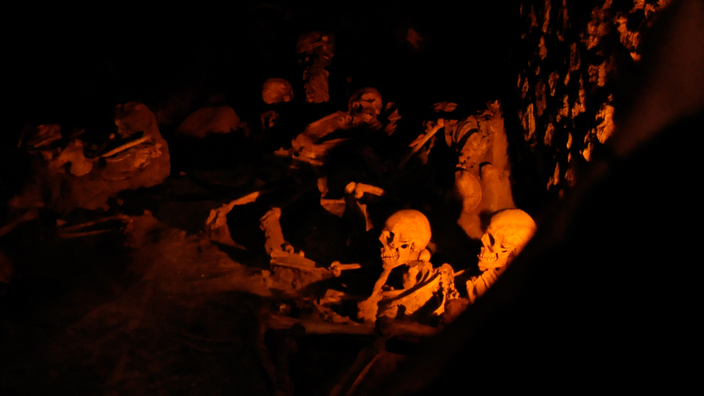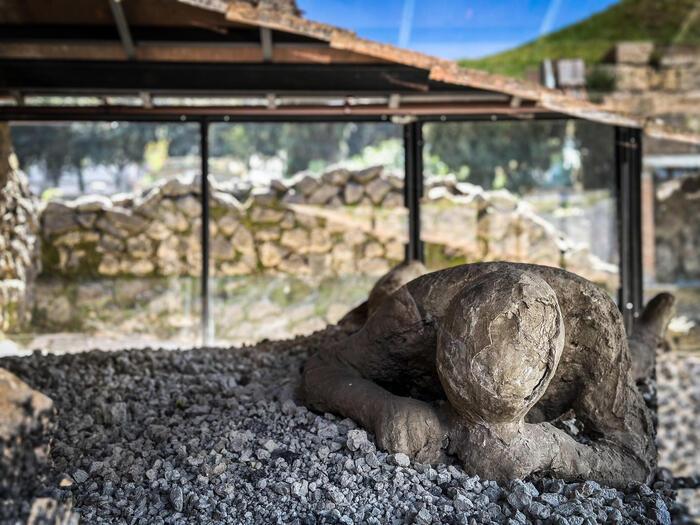The macabre of discovery befits the days leading up to Halloween.
Italian workers engaged in clearing a lane on the immediate outskirts of the ancient city of Herculaneum discovered a corpse embedded in a wall last week.
Or rather half of a corpse.
His severed femurs, only protruding from the rock his lumbar vertebrae, his pelvis and the top of his hips, of a disturbing crimson color.
Caught in a fiery cloud during the ancient eruption of Vesuvius at the start of Titus' reign, the victim remained trapped in its volcanic matrix for nearly two millennia.
Read alsoThe Roman remains discovered in Herculaneum was an officer of the imperial fleet
"It is a discovery from which we expect a lot",
welcomed, to the Italian press agency Ansa, the director of the Archaeological Park of Herculaneum, Francesco Sirano. The enthusiasm heard from the archaeologist does not leave Jupiter's thigh. Discovered as part of the development work of a new visit itinerary linking the old maritime facade of Herculaneum to the Villa of the Papyrus, the skeleton buried in 79 AD. AD was on the city beach. A space where the evacuation operations of the inhabitants of this city nestled at the foot of Vesuvius must have been concentrated. At the center of the attention of the archaeologists of the park for several months, the excavation of the site could reveal new details on theorganization and conduct of the Herculanyum marine rescue.
Identified as a 40-45-year-old male individual, the skeleton is expected to be mined from the volcanic rock in the coming days using high-precision tools. The causes of his death appear as obvious as they are painful in the eyes of Italian archaeologists.
“His last moments were appalling, but instantaneous,”
said Francesco Sirano. Caught up on the beach by an infernal pyroclastic flow going at 100 km / hour, this anonymous Roman was instantly boiled alive by a wall of flames and incandescent ash of several hundred degrees, between 300 and 700 ° C according to estimates. The garnet coloration of his bones, which persisted after nearly 2000 years, is believed to come from his blood.
Read also 2000 years ago, the eruption of Vesuvius boiled brains and exploded skulls
Who was he ? An inhabitant who was trying to reach the sea? Or
"a rescuer"
, as proposed by the Italian archaeologist in charge of the Herculaneum site. The Roman fleet of Misene, stationed north of the Bay of Naples under the command of Pliny the Elder, had been dispatched to come to the aid of the inhabitants of the shores of Vesuvius. The operations, poorly known archaeologically, had however been hampered by the difficult conditions of the eruption and by the fiery clouds, trapping on the beaches the inhabitants and some of the sailors who came to help. One of these rescuers, perhaps a naval officer according to the latest interpretations, had been discovered about 20 meters from the new deceased. The two individuals could thus have served on the same vessel,suggested Francesco Sirano.
Civilian or military, the new victim was spotted in the middle of various charred objects, including a roof beam that could have smashed his skull. According to archaeologists, traces of textiles and metals also seem to surround the deceased. Whether they were coins, a bag or various tools, these objects could prove to be decisive in the identification of the deceased. A laboratory analysis of all the remains will provide new details on its identity in the coming months. Carried away in appalling conditions, this unfortunate man was
"perhaps the last and the most unlucky of a group which had succeeded in taking to sea"
, for example proposed the director of the Archaeological Park of Herculaneum.
Despite an unknown number of victims within the rescue forces, several hundred inhabitants were however evacuated by sea thanks to the reactivity of the Roman fleet of Misene.















